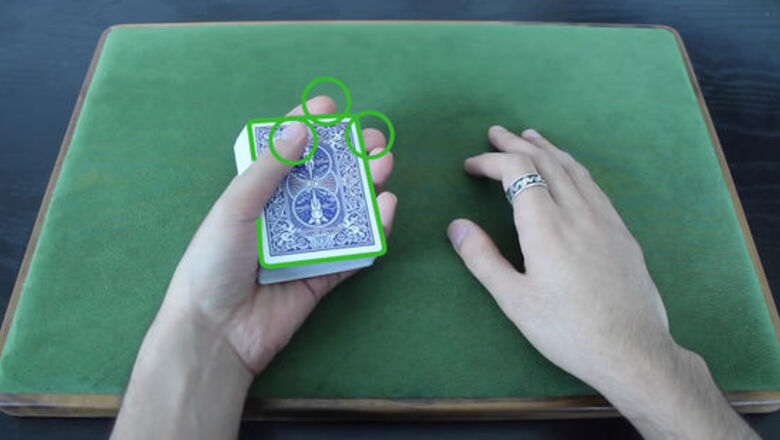
views
Fanning Cards with Two Hands
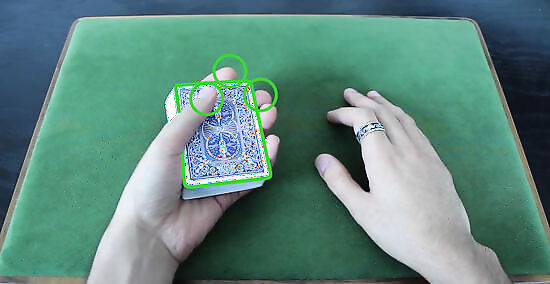
Hold the deck of cards loosely between your left thumb and fingers. Put your left hand out as though you were holding a cup of water, with your thumb nearest you. Place the deck of cards in between your thumb and index finger, keeping it flat with the face side down. Place your index and middle finger against the underside of the deck. The tip of your middle finger should be against the near right corner of the deck, with your index finger alongside it. Loosely hold the deck by placing your thumb across the top of the deck, with the tip about halfway across the nearest edge. Being left-handed or right-handed doesn't make too much of a difference, but you can try using your right hand instead if you keep dropping the cards.
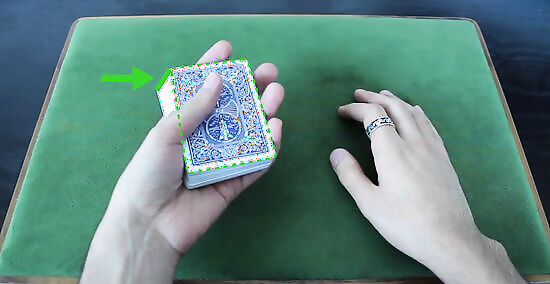
Angle the cards slightly. Shift the top of the deck slightly, so the top cards are very slightly more to the right than the cards beneath them. This small angle helps the cards fan out more evenly, although this step becomes less important with practice.
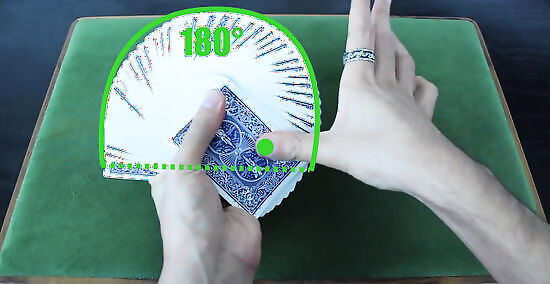
Fan the cards with your right thumb. Bring your right thumb onto the left edge of the deck, and use it to push the cards into a fan shape, pivoting around your left thumb. Press down slightly with your thumb as you do this, but keep it gentle enough that the cards spread out in an even fan instead of clumping together in chunks. Ideally, you should finish the fan with the cards spread out in a full 180º semicircle. You can use your right fingers instead of your thumb. You can think of this movement as pulling the stack of cards away from the bottom-most card in turn. If the entire deck moves together, hold it more loosely, or try consciously moving your right thumb at an upward angle as you spread
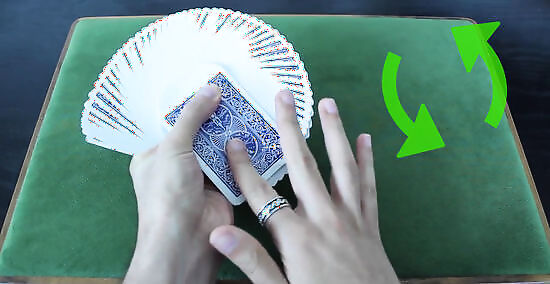
Practice. Magicians make fanning cards look easy, but they've put in many hours of practice. Keep practicing until you can fan the cards smoothly and evenly. Speed up your fan as you become more experienced, but don't become so fast that you ruin the grace and fluidity of the fan. Replace your deck if the cards become more difficult to fan. Worn cards may not spread as evenly.
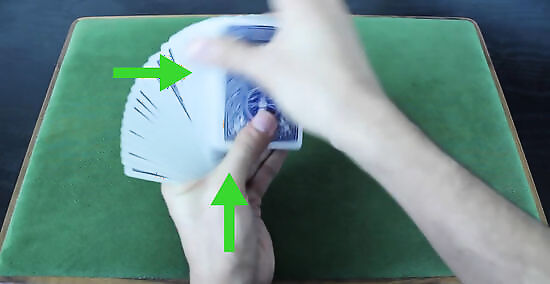
Flick up your left wrist as you thumb with your right. Try this advanced technique to increase the speed at which the cards fan out. With this wrist flick upwards, as you are pulling the cards down with your thumb, you are simultaneously pulling the cards up with your left hand.
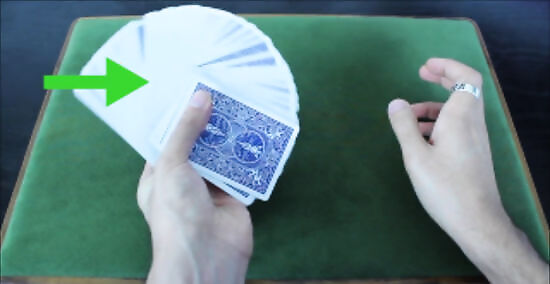
Practice the one-handed close. It's easy to close the fan again with your free hand, moving the cards in the same direction as the fan to put them back into one stack. For a more advanced technique, practice using the fingers holding the cards to pull them closed instead. You may need to "walk" your fingers a few times along the underside of the cards to manage this, and it can take a fair amount of practice before you can do this confidently and without dropping cards.
Fanning Cards with One Hand
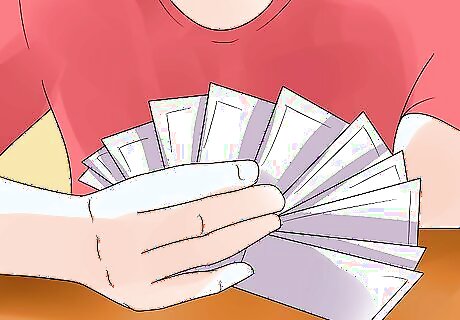
Try this with half a deck first. This fan is most easily done with approximately half the playing card deck, although it can be done with a whole deck with practice. Practicing with half a deck is recommended. This fan is more difficult than the two-handed fan, and some familiarity with that method may be useful. Once you are an expert at this fan, try dividing a deck in two and fanning each half with a different hand, simultaneously.
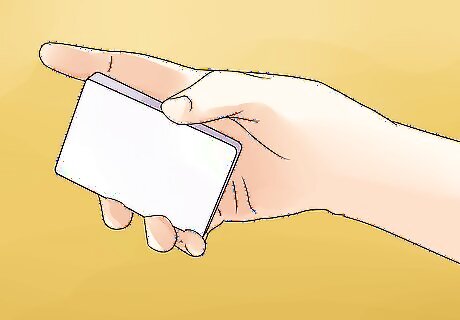
Grip the deck in your dominant hand. Square the cards together in a neat stack. Hold the deck with your first and fifth fingers on opposite long edges. Put your third and fourth fingers along one short edge, and your thumb on the remaining short edge. Each finger should cover the entire width of the deck and protrude slightly beyond it. Turn your hand so the deck is held vertically, with the thumb along the upper edge. This grip should be secure enough that you can lift your thumb and rotate the deck in any direction without spilling cards. You can skip straight to the position described below, with your thumb in the lower left corner. However, this is a good starting position to practice from if you plan on learning more advanced card tricks and flourishes.
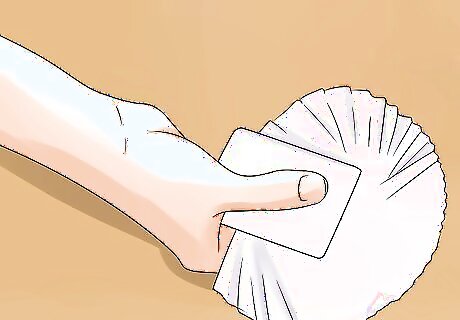
Lift your thumb and tilt the deck outward. Remove your thumb from the upper edge. Tilt the deck outward, away from you, and curl up your third and fourth fingers to grip the bottom edge.
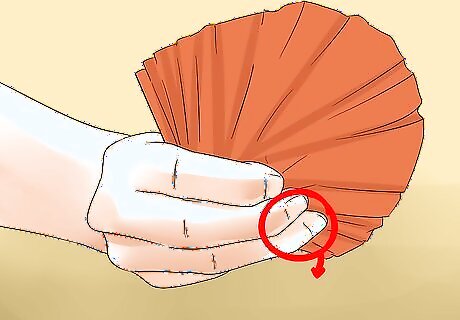
Place your thumb against the lower left corner, moving your other fingers. This is the lower left corner of the top surface of the deck, nearest to you. Once your thumb is in position, move your first and fifth fingers away from the sides and down to the lower edge, so all four finger are supporting the deck from below. This can take a little practice to time the movement of your first finger, so as not to drop the cards. Depending on the length of your thumb, you may prefer to place your thumb along the left edge of the top card instead, less than an inch (2.5 cm) from the lower corner. Placing your thumb nearer the center of the top card is a common mistake, so concentrate. If you are holding the deck in your left hand, instead place the thumb against the lower right corner.
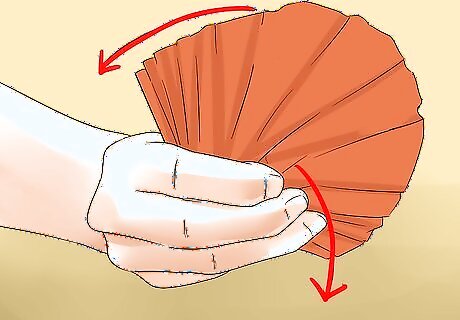
Spread your thumb and fingers in opposite directions. Fan the cards by moving your thumb clockwise, while you move all four fingers counterclockwise, in the opposite direction. (Reverse these directions for a deck in your left hand.) A fast spread will make the cards fan more smoothly. You can think of this motion as "snapping" all four fingers against your thumb. At the end of the fan, the fleshy part of your hand beneath your thumb will help support the fanned-out cards.

Misdirect the audience. Once you've got this motion down, practice some sleight of hand while using it in your tricks: Secretly removing the top half of the deck before fanning still results in a fan that looks like a full deck, and will prevent an audience member from picking the top card. Hold the card fan vertically, directly in front of the audience member's face. This will distract him while your other hand performs an manipulations necessary with the other half of the deck.















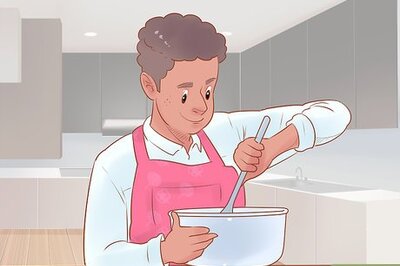


Comments
0 comment